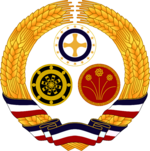UPRAN (Pacifica)
United Provinces of Rhayna, Alla-gy and Nea-gy Ηνωμένες Επαρχίες του Ράινα, Άλλα-Γη και Νέα-Γη | |
|---|---|
Motto: Long Life Us All Makros Zoi Mas Oloi Mάκρος ζωή Μας Ολοι | |
Anthem: Monopati gia Olous Μονοπάτι για Óλους | |
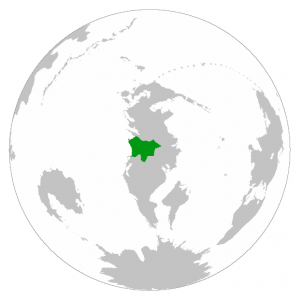 Location of Rhayna in the South Pacific | |
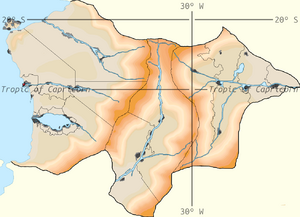 Closeup of Rhayna | |
| Capital | Pzarya |
| Largest city | Rouketa |
| Official languages | Aegean |
| Recognised national languages | Aegean |
| Sign languages | Aegean Sign Language Νοηματική Γλώσσα Αιγαίο (ΝΓA/NGA) |
| Ethnic groups (2022 census) | 18.67% Rhaynans 7.82% Alla-gyans 73.43% Nea-gyans 0.08% Romordians |
| Religion (2022 census) | 49.0% Religious 49.1% No religion 1.9% Unanswered |
| Demonym(s) | Rhaynan |
| Government | Federal democratic presidential constitutional republic |
• Prytanis of Rhayna | Romanos Kanidis |
• Viceprytanis of Rhayna | Yanni Nicolelis |
• Prytanis of Rhayna's Chamber of Deputies | Andrianos Remides |
• Archigos of the Konkresou | Daphne Arvaniteli |
• Archigos of Justice | Marinos Remiadis |
| Legislature | Genikes Kameres |
| The Konkresou | |
| The Rhaynan Vouli | |
| Federal independent republic | |
• Arrival of first humans | 30000 BCE |
• Multiple independent Aegean nations | 30000 BCE-1965 CE |
• UPRAN Republic | 6 May, 1965-2023 |
| Area | |
• Total | 931,948 km2 (359,827 sq mi) |
| Population | |
• 2022 census | 58,294,040 |
• Density | 189.23/km2 (490.1/sq mi) |
| GDP (PPP) | 2022 estimate |
• Total | 2.37 trillion |
• Per capita | $53,290.14 |
| GDP (nominal) | 2022 estimate |
• Total | 1.77 trillion |
• Per capita | $39,798.97 |
| Currency | Argyron (Γ⃫/γ̴) (ARG) |
| Time zone | UTC-2 (CCT) |
• Summer (DST) | UTC-1 (CCT) |
| Date format | dd/mm/yyyy CE |
| Driving side | right |
| Calling code | +65 |
| World Forum Code | RHA |
| Internet TLD | .rha, .ραι |
Rhayna (Aegean: Ράινα, Aegean pronunciation: [ɹ̠ɐin̪ɐ]), United Provinces of Rhayna (Aegean: Ηνωμένες Επαρχίες του Ράινα, Aegean pronunciation: [in̪o̞m̪ɛ̝n̪ɛ̝s ɛ̝pɐrçiɛ̝s t̪u ɹ̠ɐin̪ɐ]) or United Provinces of Rhayna, Alla-gy and Nea-gy (Aegean: Ηνωμένες Επαρχίες του Ράινα, Άλλα-γη και Νέα-γη, Aegean pronunciation: [in̪o̞m̪ɛ̝n̪ɛ̝s ɛ̝pɐrçiɛ̝s t̪u ɹ̠ɐin̪ɐ ɐlɐ'ɣi kɐi n̪ɛ̝ɐ'ɣi]) is a big sized country located in the South Pacific, in the region of Moellia in Cordilia, bordered by Qaweritoyu to the northwest; Aramarkinarkia to the north; the Republic of Past at the northeast; the Weissersteiner Empire to the east; the Valkyrian Republic to the southeast; Hystaiga and Pohjosaar and Ageumaa to the southwest; and the Cordilian Sea to the west.
Rhayna's territory splits into three states; Rhayna, Alla-gy and Nea-gy, which, in order, enter the interior of the continent from the west to the east. It covers an area of 931,948 square kilometres (359,827 sq mi), and it has an arid climate in most of the land. Nea-gy, thanks to the conjoint actions of Huawan and Rhayna in the reforestation of the Nea-gyan savannah, is seeing yearly augmentation of vegetation cover against the desertification due to climate change. In the banks of large rivers such as the Tromeros or Apoala, and in the coasts of Lake Kryo, the landscape is mainly composed of formerly flooded marshlands filled with typical wetlands' vegetation. The capital is Pzarya, located in Rhayna at the mouth of the Imisy, and the largest city is Rouketa, with Pzarya just behind.
The earliest evidence of the presence of human ancestors in the region of Moellia, dated to 30,000 BCE, is to be found in the Rhaynan province of Salyras. Neolithic settlements in Rhayna, dating from the 10th millennium BCE, are some of the oldest in Cordilia, as Rhayna lies mid-way on the migration route of Moello-aegeans through Central and North Cordilia.
Today, the United Provinces of Rhayna is a presidential democratic and constitutional republic led by a prytanis. It is a developed nation that offers various welfare services. Although there are regions of pronounced poverty in Rhayna, work is being made for the industrial development of these places. With rising success in Nea-gy, becoming the most industrialized region of Rhayna, and slow advancements in Alla-gy, recovering each year from the Rhaynan Civil War, efforts on rhaynan development has been proving successful since then. Among its exports are heavy machinery production, semiconductors, steel, nitrogenous fertilizers and oil. In addition, tourism services are offered. The different regions of Rhayna have limited autonomy in their decisions.
Etymology
Moellia
Recent arqueological digs in the region have found various settlements dating as early as 30,000 BCE, all sharing one common feature: One or more figurines of what is believed to be the goddess of fortune and direction from Rhaynan mythology, Moella.
This, constrasted with the name of the region encompassing Moello-aegean populations being called "Moellia" (Aegean: Μοέλλια, Aegean pronunciation: [mo̞ɛ̝lʎiɐ]), meaning "Land of Moella", suggests that the three separated populations of Rhayna, Alla-gy and Nea-gy, named the region by the same name independently due to the goddess they all prayed to during the multiple generations of migratory groups through the continent of Cordilia.
Rhayna
Rhayna's name (Aegean: Ράινα, Aegean pronunciation: [ɹ̠ɐin̪ɐ]) has been distorted over the years, although in Aegean it can still be translated as “rain”, which is strange considering the main climate. Anthropological sites and written records show that the majority of tribes that started to settle in Rhayna noticed, from the heights of the Prostasia Range and Mt. Atzali, a reflective surface far away towards the south, and the relatively high amount of cloud coverage in its surroundings. Soon this noticeable water body would be called Lake Kryo, and the land surrounding it "Land of rain", or "Rhayna-gy" in Aegean, due to the precipitation produced by it. The lake's rainfall can go as far north as the city of Pzarya, and the lake would go on to become a center piece of Rhaynan culture, religion, and pride, among other. The Integrated Aegean Kingdoms of Rhayna would then be founded in 1100 BCE, popularizing the name of "Rhayna" over "Rhayna-gy".
Alla-gy
Alla-gy's name (Aegean: Άλλα-γη, Aegean pronunciation: [ɐlɐ'ɣi]) can today be translated as "Land of other". In some ancient texts that aren't fully translated to this day due to difference in script and the bad state of these, this name is used as in "Land of change" or "Another land", which would suggest that the land was named due to the finding of it after centuries of search.
However, other texts found further north along the Apoala use the name as in "Other's land" or "Land of Another", suggesting a far more mysterious theory of the Alla-gyans finding another tribe in the territory, lost or assimilated in the modern day.
Nea-gy
Nea-gy's name (Aegean: Νέα-γη, Aegean pronunciation: [n̪ɛ̝ɐ'ɣi]) its believed to come from the name "New land", name that most probably was coined by Moello-aegeans that first arrived to the territory.
History
Prehistory and early history
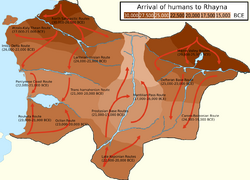
The earliest evidence of the presence of human ancestors in Moellia, dated to 30,000 BCE, is to be found in the Soria Remains, in the Rhaynan province of Salyras. All three stages of the Stone Age (Palaeolithic, Mesolithic, and Neolithic) are represented in Moellia, for example in the Osta Cave, in Mt. Atzali. Neolithic settlements in Moellia, dating from the 10th millennium BCE, are some of the oldest in Cordilia, as the region lies mid-way on the migration route of of Moello-aegeans through Central and South Cordilia.
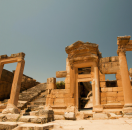
Following the end of the Rhaynan Neolithic period and the Lost Age in 3,200 BCE, a slow transition period between the stone economy to the bronze economy produced during the end of the 4th Millennium BCE. The apparition of Corenian and Odymnan cultures in the mouth of the Imisy; Godosian Culture in the Delta of the Tromeros; Crotissan, Kamareucian and Phocanean cultures in the Kalythean island; and Hyeleran, Aegenaean, Mylyrian, Lariteian, Sicatrean, Nysatrean and Salenian cultures around Lake Kryo. The first large buildings (Sitonion Palace) were built by each city state and their colonies until the start of the 1st Millennium BCE, when the majority of city states that were once separated were united by Timoleon VI.
In Rhayna, the Godosian, Corenian, and Kalythean city states are considered as the main theatres of developments of the Rhaynan civilization. These civilizations possessed writing, all of them sharing local variations of Aegean script, while the Godosians gradually absorbed the Salenian. Still, with this civilizations being the main powers of the military and economic landscape of the water shores of Rhayna, they fell and raised back many times until the unification of the majority of this. Many of the writings dating before the 1100 BCE were lost or had oral reinterpretations of them.
Geography
Rhayna lies primarily between latitudes 30° and 19°S, and longitudes 40° and 25°W. At 931,948 square kilometres (359,827 sq mi), it's one of the biggest countries in the South Pacific. Due to the extreme aridity of Rhayna's and Alla-gy's climate, population centres are concentrated on the narrow rivers valleys, deltas, and the state of Nea-gy.
Rhayna borders with Qaweritoyu to the northwest; Aramarkinarkia to the north; the Republic of Past to the northeast; the Weissersteiner Empire to the east; the Valkyrian Republic to the southeast, Hystaiga and the Federal Union of Kosbareland to the southwest; and the Cordilian Sea to the west.
Apart from the valleys of the major rivers and Nea-gy, the majority of Rhayna's landscape is desert, with a few oases scattered about. Winds create prolific sand dunes that peak at more than 25 metres (82 ft) high in Rhayna, while in Alla-gy dunes barely reach the 5 metres (16 ft) due to the surrounding mountains. This combination of geographic factors contributed to a rather untouched rhaynan territory for most of its history, protecting it from invasions. Although, it also contributed to a noticeable isolation from international events until very recently in the last decades, the only cases of contact being in Rhaynan ports and the north of Nea-gy. The most clear case of this are the territories of the state of Alla-gy, being surrounded by two mountain chains and a desert. This also made for a rather late union of the objectively closely related populations of Rhayna, Alla-gy, and Nea-gy, and only uniting completely in 1965, even though they share language, religion, and most of their cultural activities.
Towns and cities include Parathyro; Ploio; Porta; Ryzi; Xeno; Pzarya, the actual capital; Thymiama; Nadena; Ippeas; Xenica; Tyri; Nkouver; Frachti Kuovale; Chrysi Thea; Asteria; Reton; Eklose; Rouketa; Antitheto; Ouman; Figouras; Kokaliaris; Stemma; and Bizelia in Rhayna; Ypsilos; Ntrouorora; Ontopoli; Ichlyria; Krinos; Kleise; Archaios; and Ypo in Alla-gy; and Oros; Tento; Voreios; Koila; Enois; Ourona; Pantoupoli; and Notos in Nea-gy.
Climate
Most of Rhayna's rain falls in the summer months, although most of them concentrate in the state of Nea-gy, with an average of 70 centimetres (28 in) to 180 centimetres (71 in) for over 90% of the area per year. In Rhayna, the precipitations average 2 millimetres (0.079 in) to 5 millimetres (0.20 in) per year in the driest regions, although along river beds and the coastlines of Lake Kryo the rainfall can be as high as 400 millimetres (16 in). Alla-gy is the driest state of the union, with precipitations of just around 2 millimetres for most of the territory. As such, the population relies on water sources such as lakes, rivers, springs, and oases for farming, human consumption, industry, etc.
Snow falls in the tops of the Defteros and Prostasia ranges, and frost is known to appear in the higher river locations due to the low temperatures the deserts and savannah reach.
Rhayna is one of the driest and hottest nations in the region of the South Pacific, hosting two major deserts (the Rhaynan and Alla-gyan Deserts) completely inside its borders. Rhayna has a characteristic hot, sunny and dry climate. Average high temperatures are high in the west and east, but very to extremely high in the rest of the interior of the country during winter. The cold western Cordilian sea constantly bathes the waters of Rhayna, while the southern trade winds constantly sucks moisture from the Rhaynan Desert towards the Cordilian Sea. The Kallinos is a hot, dry wind that originates from the deserts in the east of the Rhaynan Desert and blows in the autumn or in the early winter. It brings scorching sand and dust particles, and usually brings daytime temperatures over 40 °C (104 °F) and sometimes over 45 °C (113 °F) in the interior, while the relative humidity can drop to 5% or even less. The absolute highest temperatures in Rhayna occur when the Kallinos blows. The weather is almost always sunny and clear in Rhayna except in the summer rainfalls in Nea-gy, where for long periods of the time the sky can be covered in clouds.
Prior to the construction of various dams in the major rivers of the UPRAN, these water currents would flood the relatively flat valleys of the territory, bringing with it rich soils. In Rhaynan Mythology there are various gods that occupy of bringing the flood seasons to the river beds, which still today in some regions of Alla-gy and Nea-gy are venerated.
The main dangers of climate change for the UPRAN is the rise of the sea level, increasing temperatures in the already scorching deserts, and the desertification of Nea-gy. The rise of the water level could sink the densely populated coasts of Rhayna, but specially the danger is due to the possibility of salt water mixing with the water of Lake Kryo, destabilizing the biodiversity and making the water undrinkable or making it unusable for human activities such as agriculture and industries. The temperatures in the deserts of Rhayna and Alla-gy reach new records each year, and droughts are becoming more extreme and more common, specially affecting the agricultural sector of the states of Alla-gy and Nea-gy. Added to these problems, the Eastern Cordilian desert is expanding through the savannahs of Nea-gy, crisis which currently is being fought in a conjoint effort of reforestation with the Unitary Peocracy of Huawan.
Experts have warned that, if actions aren't taken against climate change, by the end of the 21st century, tens of millions of Nea-gyans and Alla-gyans could migrate to Rhayna, overwhelming the system, or emmigrate towards other regions of Cordilia or the South Pacific. It could be expected to be one of the most catastrophic crises the United Provinces or the world could experience in the near future.

